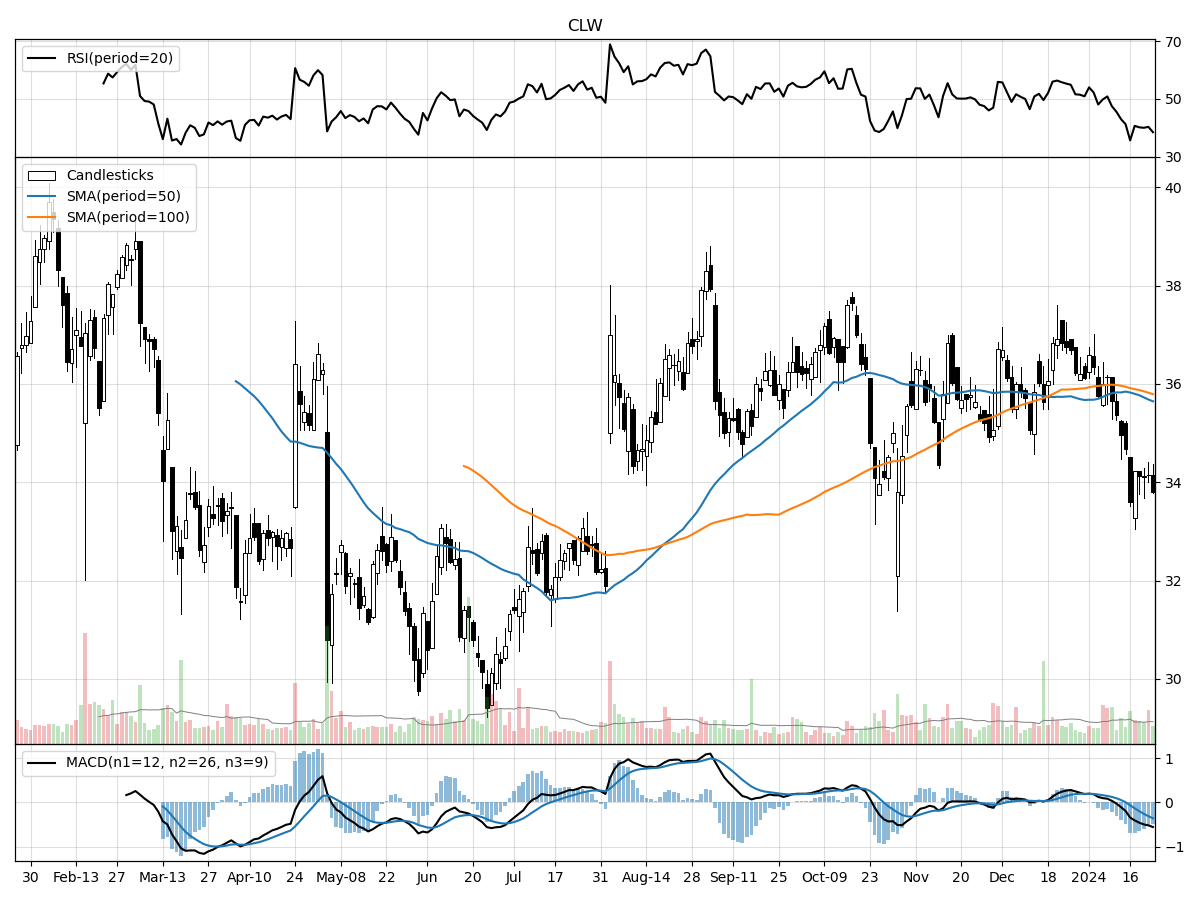Clearwater Paper Corp (CLW),Mid/Small Cap AI Study of the Week
Clearwater Paper Corp has demonstrated a resilient financial performance, particularly noteworthy in the current economic climate. Despite a slight decrease in net sales, the company's net income soared to $36.6 million in Q3 2023...

January 25, 2024
Weekly AI Pick from the S&P 400 or S&P 600
Company Overview
Clearwater Paper Corp (CLW) is a prominent player in the production of bleached paperboard and tissue products, catering to the packaging industry and major retail chains. The company operates through two main segments: Pulp and Paperboard, which saw a significant sales increase of 20.1% to $1,136.3 million in 2022, and Consumer Products, which also experienced a growth of 13.8% to $950.2 million the same year. CLW is a key player in the Solid Bleached Sulfate (SBS) paperboard market and also sells pulp externally. With around 16% of the U.S. bleached paperboard capacity, they are a substantial force in the industry.
Despite their success, Clearwater Paper faced challenges in 2022, with rising costs for raw materials and energy impacting their expenses. Their energy contracts are market-dependent, leading to potential volatility in operating costs. Sales exhibit seasonal patterns, with the Consumer Products segment typically seeing a dip in shipments during the fourth quarter due to holiday promotions, and certain paperboard grades selling less in the first and fourth quarters.
Clearwater Paper is proactive in addressing climate change, integrating ESG issues into its corporate governance, and setting GHG emission reduction goals. However, the costs of these initiatives are non-trivial, and failure to meet their environmental targets could harm the company's reputation. They are also investing in water conservation, expanding their range of eco-friendly products, and using organic by-products for renewable energy. Additionally, the company is attentive to human capital management, with a significant portion of their workforce being unionized and ongoing initiatives to enhance workplace safety, diversity, equity, and inclusion.
By the Numbers
- Annual 2022 Net Sales: $2.1 billion (17.3% increase from 2021)
- 2022 Net Income: $46.0 million (Reversed from a net loss of $28.1 million in 2021)
- 2022 Diluted Earnings Per Share: $2.68
- 2022 Adjusted EBITDA: $226.9 million (from $174.6 million in 2021)
- Pulp and Paperboard Segment 2022 Sales: $1,104.8 million (23.4% increase)
- Pulp and Paperboard Segment 2022 Operating Income: Up by 45.9%
- Pulp and Paperboard Segment 2022 Adjusted EBITDA Margin: 19.4%
- Consumer Products Segment 2022 Sales: $950.2 million (13.8% increase)
- Consumer Products Segment 2022 Operating Income: Up by 179.0%
- Consumer Products Segment 2022 Adjusted EBITDA Margin: 7.8%
- 2022 Corporate Expenses: $71.1 million (increase due to incentive compensation)
- 2022 Interest Expense: $34.6 million (decrease due to lower debt levels)
- 2022 Capital Expenditures Projection: Between $70 million and $80 million
- 2022 Cash Flow from Operating Activities: $150.2 million
- 2022 Purchase Commitments: $129.0 million
- 2022 Purchase Commitments Related to Capital Expenditures: $26.5 million
- Q3 2023 Net Sales: $519.9 million (3.5% decrease from Q3 2022)
- Q3 2023 Net Income: $36.6 million ($2.17 per diluted share, up from $20.6 million, $1.21 per diluted share in Q3 2022)
- Nine Months Ending September 30, 2023, Net Sales: $1.6 billion (1% increase from the previous year)
- Nine Months Ending September 30, 2023, Net Income: $90.1 million ($5.29 per diluted share, up from $51.9 million, $3.04 per diluted share)
- Q3 2023 Adjusted EBITDA: $80.6 million
- Nine Months Ending September 30, 2023, Adjusted EBITDA: $217.6 million
- Consumer Products Segment Q3 2023 Operating Income and Adjusted EBITDA: Significant increase (due to higher demand for private label products and reduced input costs)
- Q3 2023 Corporate Expenses: $18.0 million
- Nine Months Ending September 30, 2023, Corporate Expenses: $58.5 million
- Nine Months Ending September 30, 2023, Net Cash from Operating Activities: $125.0 million (decrease from $132.8 million)
- 2023 Capital Expenditures Projection: Between $70 million and $80 million
- 2023 Financing Activities: Share repurchases and short-term borrowing totaling $20.7 million
Stock Performance and Technical Analysis

The technical analysis of a stock involves examining various technical indicators and chart patterns to forecast the future movement of its price. In the case of the stock under consideration, several key indicators provide insights into its potential performance.
Starting with the price movement, the stock is currently trading at $33.81, which is 15% above its 52-week low, suggesting that the stock has shown recent strength off its lows. However, it's also 14% below its 52-week high, indicating that it has retreated from its peak levels. This range-bound performance could imply that the stock is struggling to find a clear direction in the medium term. The recent price decline of about 8% in the last month might raise some concerns about short-term bearish momentum, although the relative stability over the last three months could indicate that the price is consolidating.
Volume analysis can provide further insight. The stock's recent daily volume is slightly below the longer-term average, suggesting a mild decrease in trading interest or liquidity. This could mean that the stock is not currently in high demand among traders and investors, possibly reducing the likelihood of sharp price movements.
Money flow indicators, such as the Money Flow Index (MFI), are used to gauge buying and selling pressure. In this case, the indicators suggest that the stock is under moderate selling pressure and is under distribution, which means that the stock may be sold by larger investors or institutions, potentially leading to a downtrend.
The Moving Average Convergence Divergence (MACD) is another momentum indicator that shows the relationship between two moving averages of a stock's price. A bearish MACD at -0.36 indicates that the short-term momentum is weaker than the long-term momentum, suggesting that it may not be the best time to enter a long position.
Based on this technical analysis, the stock appears to be facing some bearish signals, with selling pressure, distribution activity, and negative momentum according to the MACD. Caution should be exercised, and it may be prudent to look for additional technical or fundamental signals before deciding on an investment. It's also essential to consider the broader market conditions and the specific industry's outlook to fully understand the potential risks and rewards associated with this stock.

The ‘Bull’ Perspective
Investing in Clearwater Paper Corp: A Strategic Opportunity Amidst Market Volatility
Summary:
- Robust Financial Performance: Clearwater Paper Corp's recent financial results showcase a significant increase in net income and Adjusted EBITDA, indicating strong operational efficiency and profitability.
- Consumer Products Segment Growth: The Consumer Products segment has demonstrated impressive growth in operating income, driven by increased demand for private label products and higher retail sales prices.
- Cost Management and Input Price Reductions: Clearwater Paper has effectively managed input costs, with reduced expenses for pulp, freight, chemicals, and energy contributing to the bottom line.
- Market Position and Diversification: Despite market volatility, Clearwater Paper's strategic focus on private label offerings and process improvements positions it well for sustained growth.
- Capital Expenditure and Shareholder Value: Planned capital expenditures and share repurchase programs reflect the company's commitment to long-term growth and shareholder value.
Elaboration:
- Robust Financial Performance
Clearwater Paper Corp has demonstrated a resilient financial performance, particularly noteworthy in the current economic climate. Despite a slight decrease in net sales, the company's net income soared to $36.6 million in Q3 2023, a remarkable jump from $20.6 million in Q3 2022. The earnings per diluted share followed suit, climbing from $1.21 to $2.17. Over a nine-month period, net sales saw a modest increase, but net income experienced a profound surge to $90.1 million, or $5.29 per diluted share. Adjusted EBITDA for both the quarter and nine-month periods also saw significant improvements, reaching $80.6 million and $217.6 million, respectively. These figures underscore Clearwater Paper’s ability to enhance profitability and maintain a solid financial foundation, even in the face of broader market uncertainty. - Consumer Products Segment Growth
The Consumer Products division of Clearwater Paper has been a standout performer, with operating income and Adjusted EBITDA witnessing substantial increases. This success is attributable to heightened demand for private label products, which often gain popularity as consumers seek value in uncertain economic times. Retail sales prices in this segment have risen for both the quarter and nine-month period, a testament to the company's pricing power and improved product mix. This segment is particularly appealing to investors looking for companies that can capitalize on shifting consumer preferences toward cost-effective alternatives without sacrificing quality. - Cost Management and Input Price Reductions
Clearwater Paper's strategic cost management has been a key driver of its recent success. The company has successfully navigated the challenges posed by input cost fluctuations, particularly in pulp, freight, chemicals, and energy. By leveraging reduced input costs, Clearwater Paper has been able to bolster its operating income and Adjusted EBITDA. This adept management of variable costs is crucial, especially when considering the company's exposure to commodity price volatility and the importance of maintaining competitive pricing in the market. - Market Position and Diversification
In a market that has seen its fair share of volatility, Clearwater Paper's focus on private label products and ongoing business process improvements have fortified its market position. The company's diversification efforts, particularly in the Consumer Products segment, offer a hedge against the risks associated with reliance on a small number of key customers. As the market continues to experience shifts, such as those seen in the technology and communication services sectors, Clearwater Paper's strategic positioning in the consumer staples sector provides a level of stability and potential for growth. - Capital Expenditure and Shareholder Value
Clearwater Paper's planned capital expenditures of $70 to $80 million for 2023 reflect a commitment to future growth and operational efficiency. Concurrently, the company has engaged in activities that directly enhance shareholder value, such as share repurchases totaling $20.7 million. These moves signal to investors that Clearwater Paper is not only looking to improve its competitive edge but also remains focused on delivering returns to its shareholders. Despite the risks associated with substantial debt and the necessity to manage this debt effectively, the company's proactive financial strategies and solid cash flow generation provide a cushion against potential market headwinds.
Conclusion:
Clearwater Paper Corp presents a compelling investment opportunity for those looking to capitalize on a company with a strong financial track record, strategic market positioning, and a focus on cost management. The company's ability to adapt to consumer trends, manage input costs effectively, and commit to shareholder value amid market volatility and industry risks underscores its potential as a resilient player in the consumer staples sector. Investors seeking to diversify their portfolios with a stock that exhibits both stability and growth potential should consider Clearwater Paper Corp as a strategic addition.

The ‘Bear’ Perspective
Clearwater Paper Corp: A Cautionary Investment Perspective
Summary:
- Revenue Decline and Market Oversupply: Clearwater Paper's net sales have decreased to $519.9 million in Q3 2023 from $538.8 million in Q3 2022, indicating a challenging market with potential oversupply issues.
- Dependence on Key Customers: A small number of customers drive a significant portion of CLW's revenue, making the company vulnerable to changes in purchasing patterns and negotiating power.
- High Operational Costs and Supply Chain Risks: Rising costs for raw materials, potential supply chain disruptions, and reliance on a limited supplier base could adversely affect profitability.
- Debt and Financial Constraints: With approximately $569 million in debt and substantial covenant restrictions, CLW's financial flexibility is limited, increasing the risk of insolvency in adverse market conditions.
- Environmental and Regulatory Pressures: Compliance with stringent environmental regulations and the potential for fines, along with the risks associated with climate change, add to operational costs and uncertainties.
Elaboration:
- Revenue Decline and Market Oversupply
Clearwater Paper's recent decline in net sales from $538.8 million in Q3 2022 to $519.9 million in Q3 2023 raises concerns about the company's growth trajectory. This 3.5% year-over-year decrease signals potential market oversupply, especially in the tissue market, which could lead to further price reductions and margin compression. The Pulp and Paperboard segment, in particular, has seen a downturn in sales and operating income due to decreased demand and sales volumes, which is concerning given that this segment is already facing cyclical challenges. This market dynamic, coupled with the subdued and bumpy start to 2024 in the financial markets, suggests that investors should be cautious about the potential for Clearwater Paper to recover its sales momentum in the near term. - Dependence on Key Customers
The company's reliance on a small number of key customers is a significant risk factor. If these customers decide to decrease their orders or are able to negotiate less favorable terms due to market conditions or increased bargaining power, Clearwater Paper's revenue and financial health could be negatively impacted. This risk is exacerbated by the current market environment, where consumer purchasing trends are shifting, and retail clients are continuously seeking cost efficiencies. The company's Consumer Products segment, although currently benefiting from increased demand for private label products, is particularly susceptible to these changes. - High Operational Costs and Supply Chain Risks
Operational costs are a persistent concern for Clearwater Paper, with raw materials like market pulp and wood fiber being significant inputs that are subject to price volatility. The company has experienced reduced input costs in recent quarters, but there is no guarantee that this trend will continue. Supply chain risks, including disruptions and a limited supplier base for raw materials and equipment, could lead to production halts or delays, impacting sales and profitability. Additionally, transportation services, which are crucial for the company's operations, are facing their own set of challenges, including potential disruptions and cost fluctuations. - Debt and Financial Constraints
Clearwater Paper's substantial debt load of approximately $569 million is a red flag for investors. This debt could limit the company's ability to secure future financing and restrict operational flexibility. The company's existing Credit Agreement includes covenants that could hamper its operations and capital-raising efforts, and there is uncertainty regarding future covenant compliance. With only about $264.3 million in available credit as of December 31, 2022, the company's ability to navigate economic downturns or rising interest rates is constrained, increasing the risk of insolvency. - Environmental and Regulatory Pressures
Environmental regulations pose ongoing compliance costs and potential fines, which can impact the company's financial results. Moreover, climate change presents risks of physical damage to facilities and supply chain interruptions, adding to operational uncertainties. Clearwater Paper's commitment to environmental stewardship is commendable, but it does come with financial implications that need to be considered, especially given the current market volatility and the emphasis on sustainability in investment decisions.
In conclusion, while Clearwater Paper Corp has shown some areas of strength, particularly in its Consumer Products segment, the combination of market oversupply, customer concentration risk, operational and supply chain vulnerabilities, substantial debt, and environmental pressures present significant challenges. Investors should weigh these risks carefully against any potential upside, especially in a market environment that remains uncertain and volatile.




Comments ()